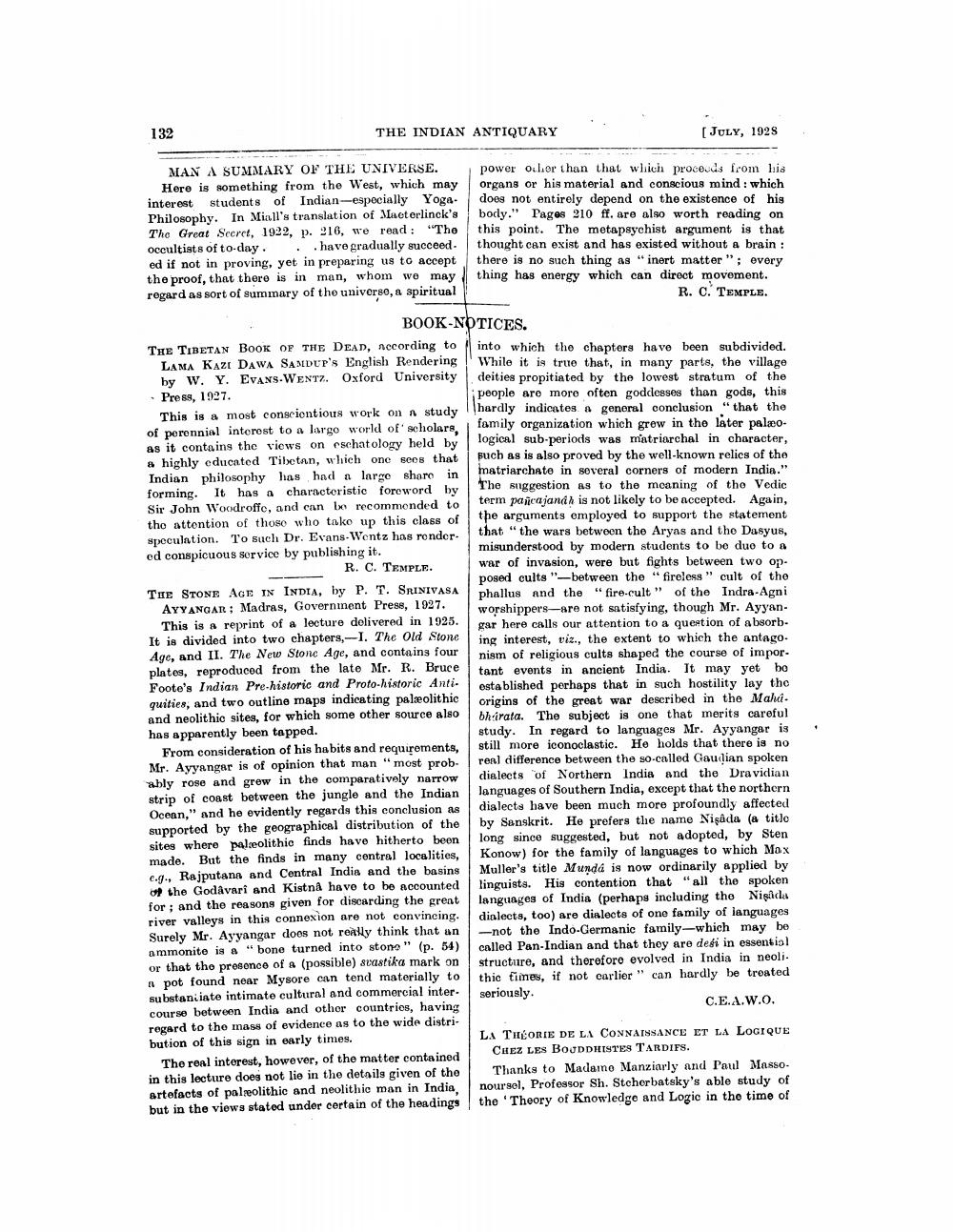________________
132
THE INDIAN ANTIQUARY
[JULY, 1928
MAN A SUMMARY OF THE UNIVERSE. Here is something from the West, which may interest students of Indian-especially Yoga. Philosophy. In Miall's translation of Maeterlinck's The Great Secret, 1922, p. 216, we read: "The occultists of to-day. .have gradually succeed. ed if not in proving, yet in preparing us to accept the proof, that there is in man, whom we may rogard as sort of summary of the universo, a spiritual
power oiler than that which proceds from his organs or his material and conscious mind : which does not entirely depend on the existence of his body." Pages 210 ff. are also worth reading on this point. The metapsychist argument is that thought can exist and has existed without a brain : there is no such thing as "inert matter " ; overy thing has energy which can direct movement.
R. C. TEMPLE.
BOOK-NOTICES. THE TIBETAN BOOK OF THE DEAD, according to into which the chapters have been subdivided.
LAMA KAZI DAWA SANDUP's English Rendering While it is true that, in many parts, the village
by W. Y. EVANS.WENTZ. Oxford University deities propitiated by the lowest stratum of the • Press, 1927.
people are more often goddesses than gods, this This is a most conscientious work on A study Ihardly indicates general conclusion" that the of poronnial interest to a largo world of scholars,
family organization which grew in the later palæoas it contains the views on eschatology held by logical sub-periods was matriarchal in character, a highly educated Tibetan, which one sees that such as is also proved by the well-known relies of the Indian philosophy has had a large share in matriarchate in several corners of modern India." forming. It has a characteristic foreword by
The suggestion as to the meaning of the Vedic Sir John Woodroffe, and can be recommended to
term pancajand is not likely to be accepted. Again, the attention of those who take up this class of
the arguments employed to support the statement speculation. To such Dr. Evans-Wentz has ronder. that "the wars between the Aryas and the Dasyus, ed conspicuous service by publishing it.
misunderstood by modern students to be due to a R. C. TEMPLE.
war of invasion, were but fights between two op
posed cults "-between the "fireless" cult of the THE STONE AGE IN INDIA, by P. T. SRINIVASA
phallus And the "fire-cult” of the Indra-Agni AYYANGAR ; Madras, Government Press, 1927.
worshippers-are not satisfying, though Mr. Ayyan. This is a reprint of a lecture delivered in 1925.
gar here calls our attention to a question of absorb. It is divided into two chapters.--1. The Old Stone
ing interest, viz., the extent to which the antago. Age, and II. The New Stone Age, and contains four
nism of religious cults shaped the course of impor. plates, reproducod from the late Mr. R. Bruce
tant events in ancient India. It may yet be Foote's Indian Pre-historic and Proto-historic Anti.
established perhaps that in such hostility lay the quities, and two outline maps indicating paläolithic
origins of the great war described in the Mahu. and neolithic sites, for which some other source also
bh-irata. The subject is one that merits careful has apparently been tapped.
study. In regard to languages Mr. Ayyangar is From consideration of his habits and requirements, still more iconoclastic. He holds that there is no Mr. Ayyangar is of opinion that man "most prob. real difference between the so-called Caulian spoken ably rose and grow in the comparatively narrow dialects of Northern India and the Dravidian strip of coast between the jungle and the Indian languages of Southern India, except that the northern Ocean," and he evidently regards this conclusion as dialects have been much more profoundly affected supported by the geographical distribution of the by Sanskrit. He prefera the name Nişada (a title sites where paleolithic finds have hitherto been long since suggested, but not adopted, by Sten made. But the finds in many central localities, Konow) for the family of languages to which Mox c... Rajputana and Central India and the basins Muller's title Munda is now ordinarily applied by of the Godavari and Kistnå have to be accounted linguists. His contention that "all the spoken for ; and the reasons given for discarding the great languages of India (perhaps including the Nişada river valleys in this connexion are not convincing. dialects, too) are dialects of one family of languages Surely Mr. Ayyangar does not really think that an
- not the Indo-Germanic family-which may be ammonite is a "bone turned into stono" (p. 54) I called Pan-Indian and that they are des
called Pan-Indian and that they are desi in essential or that the presence of a (possible) svastika mark on structure, and therefore evolved in India in neoli. 1 pot found near Mysore can tend materially to thic times, if not earlier " can hardly be treated substani inte intimate cultural and commercial inter.
seriously. course between India and other countrios, having
C.E.A.W.O. regard to the mass of evidence as to the wide distribution of this sign in early times.
LA THÉORIE DE LA CONNAISSANCE ET LA LOGIQUE The real interest, however, of the matter contained
CHEZ LES BOUDDHISTES TARDIFS. in this lecture does not lie in the details given of the Thanks to Madame Manziarly and Paul Massoartefacts of paleolithic and neolithio man in India, noursel, Professor Sh. Steherbatsky's able study of but in the views stated under certain of the headings the 'Theory of Knowledge and Logic in the time of




